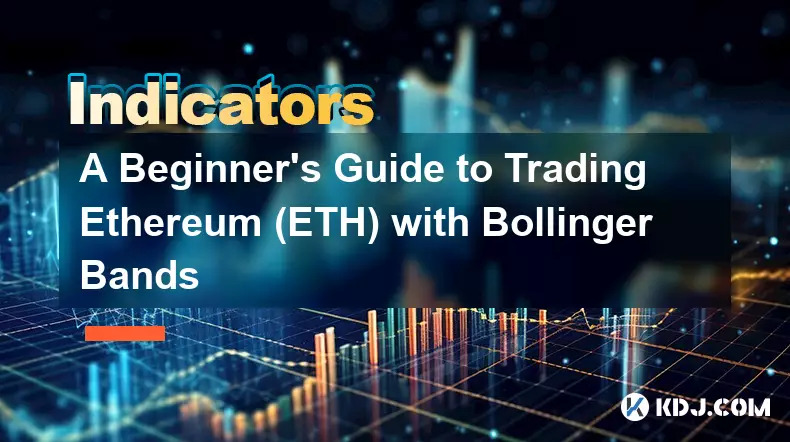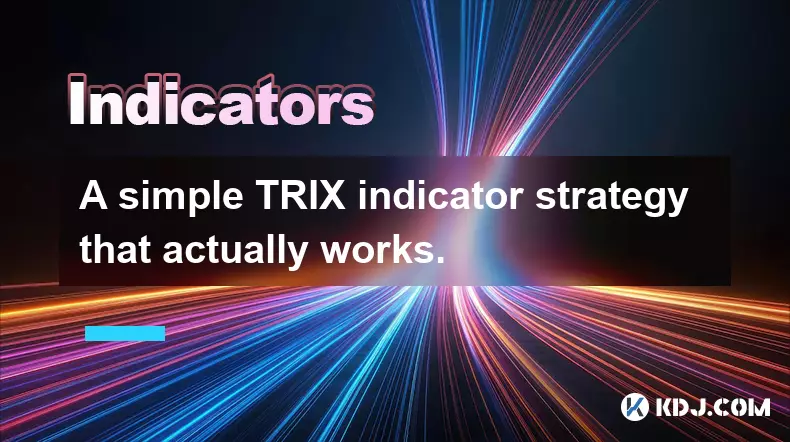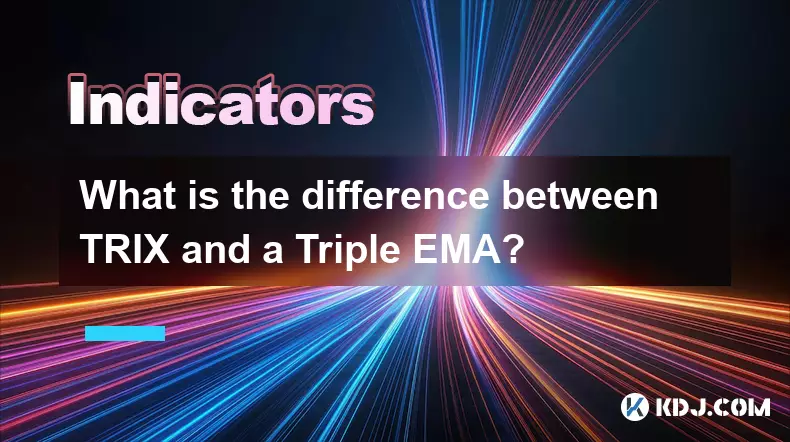-
 bitcoin
bitcoin $105968.894684 USD
4.17% -
 ethereum
ethereum $3639.320047 USD
7.62% -
 tether
tether $1.000339 USD
0.06% -
 xrp
xrp $2.407774 USD
5.96% -
 bnb
bnb $1011.704193 USD
2.28% -
 solana
solana $166.942754 USD
6.37% -
 usd-coin
usd-coin $1.000143 USD
0.03% -
 tron
tron $0.291515 USD
0.25% -
 dogecoin
dogecoin $0.181682 USD
4.06% -
 cardano
cardano $0.585450 USD
4.54% -
 hyperliquid
hyperliquid $42.099968 USD
5.20% -
 chainlink
chainlink $16.160745 USD
5.45% -
 zcash
zcash $645.269648 USD
12.96% -
 bitcoin-cash
bitcoin-cash $507.430338 USD
2.80% -
 stellar
stellar $0.290357 USD
3.69%
A Beginner's Guide to Trading Ethereum (ETH) with Bollinger Bands
Bollinger Bands help Ethereum traders gauge volatility and potential reversals, but should be combined with other indicators to avoid false signals.
Nov 05, 2025 at 04:05 am

Understanding Bollinger Bands in the Context of Ethereum Trading
1. Bollinger Bands, developed by John Bollinger in the 1980s, consist of three lines plotted on a price chart: the middle band is a simple moving average (SMA), typically over 20 periods, while the upper and lower bands are set two standard deviations away from the SMA. These bands dynamically expand and contract based on market volatility, making them particularly useful for traders analyzing Ethereum’s often volatile price movements.
2. When the bands widen, it indicates increased volatility, which is common during major news events or large-scale trades in the ETH market. Conversely, when the bands contract, it signals reduced volatility, often preceding a breakout. Traders can use this contraction as an early warning sign to prepare for potential sharp price moves in either direction.
3. The position of the Ethereum price relative to the bands provides insight into possible overbought or oversold conditions. If ETH consistently touches or exceeds the upper band, it may suggest that the asset is overbought and due for a pullback. On the other hand, repeated contact with the lower band could indicate oversold conditions, potentially signaling a reversal or bounce.
4. It's crucial to avoid relying solely on Bollinger Bands for trading decisions. While they offer valuable context about volatility and price extremes, they do not predict direction. Combining them with volume indicators or momentum oscillators like the Relative Strength Index (RSI) enhances their reliability when applied to ETH trading strategies.
Strategies for Using Bollinger Bands with Ethereum
1. One popular strategy is the 'Bollinger Squeeze,' which occurs when the bands narrow significantly, indicating low volatility. In the Ethereum market, such squeezes often precede explosive price movements. Traders watch for a strong candlestick closing outside the bands after a squeeze, using it as a signal to enter a trade in the breakout direction.
2. Another approach involves mean reversion trading. When the price of ETH moves beyond the upper or lower band, some traders assume it will revert to the middle SMA. For instance, if ETH spikes above the upper band and then closes back inside, it might be a cue to sell or short, anticipating a return toward the centerline.
3. Trend-following traders adjust how they interpret Bollinger Bands based on the prevailing market direction. In an uptrend, prices often ride along the upper band, and dips toward the middle band can present buying opportunities. During downtrends, sustained movement near the lower band suggests continued bearish pressure, with rallies to the middle band offering potential short entries.
4. Some traders use the bands to identify divergences. If Ethereum makes a higher high but the corresponding momentum indicator does not confirm it, and the price fails to reach the upper band, this divergence may warn of weakening bullish strength and an impending reversal.
Common Mistakes Beginners Make with Bollinger Bands on ETH
1. A frequent error is treating touches of the upper or lower band as automatic buy or sell signals. Ethereum can remain overextended for extended periods during strong trends, leading to premature exits or entries if bands are misinterpreted. For example, during bull runs, ETH may hover near the upper band for days without reversing, causing traders who sold at the first touch to miss further gains.
2. Ignoring the broader market context increases the risk of false signals. Events such as protocol upgrades, regulatory announcements, or macroeconomic shifts can drive ETH price action independently of technical patterns. Relying purely on Bollinger Bands without considering these factors may result in poorly timed trades.
3. Using default settings without adjusting for Ethereum’s unique behavior limits effectiveness. While the standard 20-period SMA and two standard deviations work in many cases, some traders find better results using slightly different parameters based on specific timeframes or market cycles.
4. Overtrading based on minor fluctuations within the bands leads to unnecessary losses. Not every touch or crossover warrants action. Patience and confirmation through additional indicators or price patterns improve decision-making accuracy when trading ETH.
Frequently Asked Questions
What timeframe is best for applying Bollinger Bands to Ethereum trading?The optimal timeframe depends on the trader’s style. Short-term traders often use 1-hour or 4-hour charts to capture intraday swings, while swing traders prefer daily charts for more reliable signals. Lower timeframes increase noise, making false breakouts more common.
Can Bollinger Bands be used during ETH sideways markets?Yes, they are especially effective in ranging markets. When Ethereum trades between clear support and resistance levels, Bollinger Bands help identify potential reversal points at the upper and lower bands, supporting counter-trend strategies.
How should I combine Bollinger Bands with volume analysis for ETH?Watch for volume spikes when the price approaches or breaks out from the bands. Increased volume during a breakout from a squeeze adds credibility to the move. Low-volume tests of the bands may indicate weak conviction and potential reversals.
Do Bollinger Bands work well with other cryptocurrencies?They are widely applicable across digital assets. However, each coin exhibits different volatility profiles. Ethereum’s relatively high liquidity and consistent trading activity make Bollinger Bands more reliable compared to lesser-known altcoins with erratic price behavior.
Disclaimer:info@kdj.com
The information provided is not trading advice. kdj.com does not assume any responsibility for any investments made based on the information provided in this article. Cryptocurrencies are highly volatile and it is highly recommended that you invest with caution after thorough research!
If you believe that the content used on this website infringes your copyright, please contact us immediately (info@kdj.com) and we will delete it promptly.
- Ripple (XRP) in 2026: Hold or Fold? A Look at XRP's Future and Emerging DeFi Alternatives
- 2025-11-08 18:35:01
- Zcash ZEC Coin Price Explosion: From Privacy Niche to Center Stage
- 2025-11-08 18:55:01
- Berachain Price Prediction: Navigating the Honeycomb Hype in Crypto
- 2025-11-08 18:55:01
- Arthur Hayes, Gold, and Bitcoin: A Modern Monetary Trinity?
- 2025-11-08 19:15:01
- Shiba Inu's Next Move: Navigating a Shifting Market
- 2025-11-08 19:20:01
- Pakistan's Crypto Crossroads: Balancing Opportunity with Asset-Backed Realities
- 2025-11-08 19:20:01
Related knowledge

How do professional traders use the TRIX indicator?
Nov 06,2025 at 04:40pm
Understanding the TRIX Indicator in Crypto TradingThe TRIX (Triple Exponential Average) indicator is a momentum oscillator used by professional trader...

Can I use the TRIX indicator on my mobile trading app?
Nov 07,2025 at 07:40pm
The TRIX indicator, a momentum oscillator designed to filter out short-term fluctuations and highlight long-term trends, has become increasingly popul...

How to code a simple TRIX indicator script in Pine Script?
Nov 07,2025 at 06:20am
How to Code a Simple TRIX Indicator in Pine Script The TRIX (Triple Exponential Moving Average) indicator is widely used in cryptocurrency trading to ...

A simple TRIX indicator strategy that actually works.
Nov 08,2025 at 05:39pm
Understanding the TRIX Indicator in Crypto Trading1. The TRIX (Triple Exponential Average) indicator is a momentum oscillator designed to filter out s...

What is the difference between TRIX and a Triple EMA?
Nov 10,2025 at 04:00am
Understanding Decentralized Exchanges in the Crypto Ecosystem1. Decentralized exchanges (DEXs) have emerged as a cornerstone of blockchain innovation,...

How to trade TRIX indicator signals on the 1-hour chart?
Nov 07,2025 at 05:39am
Bitcoin's Role in Decentralized Finance1. Bitcoin remains the cornerstone of decentralized finance, serving as a benchmark for value and security acro...

How do professional traders use the TRIX indicator?
Nov 06,2025 at 04:40pm
Understanding the TRIX Indicator in Crypto TradingThe TRIX (Triple Exponential Average) indicator is a momentum oscillator used by professional trader...

Can I use the TRIX indicator on my mobile trading app?
Nov 07,2025 at 07:40pm
The TRIX indicator, a momentum oscillator designed to filter out short-term fluctuations and highlight long-term trends, has become increasingly popul...

How to code a simple TRIX indicator script in Pine Script?
Nov 07,2025 at 06:20am
How to Code a Simple TRIX Indicator in Pine Script The TRIX (Triple Exponential Moving Average) indicator is widely used in cryptocurrency trading to ...

A simple TRIX indicator strategy that actually works.
Nov 08,2025 at 05:39pm
Understanding the TRIX Indicator in Crypto Trading1. The TRIX (Triple Exponential Average) indicator is a momentum oscillator designed to filter out s...

What is the difference between TRIX and a Triple EMA?
Nov 10,2025 at 04:00am
Understanding Decentralized Exchanges in the Crypto Ecosystem1. Decentralized exchanges (DEXs) have emerged as a cornerstone of blockchain innovation,...

How to trade TRIX indicator signals on the 1-hour chart?
Nov 07,2025 at 05:39am
Bitcoin's Role in Decentralized Finance1. Bitcoin remains the cornerstone of decentralized finance, serving as a benchmark for value and security acro...
See all articles





















![The Graph Price Prediction [GRT Crypto Price News Today] The Graph Price Prediction [GRT Crypto Price News Today]](/uploads/2025/11/07/cryptocurrencies-news/videos/690d4df44fe69_image_500_375.webp)




















































